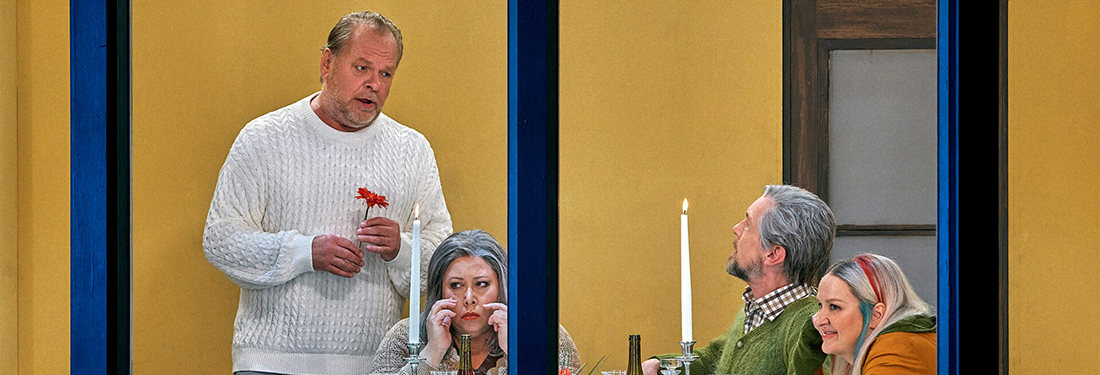
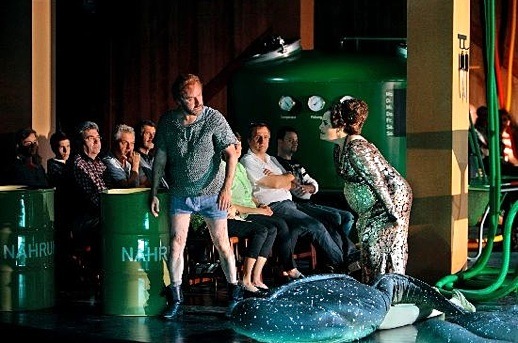
If salvation exists, it’s in the form of evolution; the possibility that we might create a life form that has a less a punishing existence than ours. Or so director Sebastian Baumgarten incoherently argued in his not-so-hot mess of a new production of Tannhäuser for Bayreuth.
The set is a new version of a massive installation by artist Joep van Lieshout entitled “The Technocrat.” Spread out over three levels, it shows a fully self-contained factory/community where the excrement of the workers is harvested to make biogas, which is then used to make their food and all-important alcohol. This huge factory is run by Wartburg industries. The program notes point out that this setting “parallels the traditional setting of Tannhäuser” as it is a place of power, society, systems and conventions…[that] stands quite opposite the Venus mountain where individual hedonistic freedom rules.“ In the front are two areas for spectators, whose purpose, I suppose, is to let the audience know that we, too are plugged into the Matrix, part of the Technocrat system.
The Venusberg is a round cage that rises from the floor with a few tall rocky structures inside to suggest a cave. Garish lights constantly change color while cavemen do aerobics and creatures that are either tadpoles or sperms recreate the choreography for “The Madison” number in Hairspray. Venus, who is pregnant, is done up as a low-budget evil sci-fi queen while Tannhäuser dances in his grungy underwear and T-shirt. All in all, it looks like a really sad theme night at Area.
When Tannhäuser returns to earth, he is greeted by the shepherd, here a perpetually sozzled, tiresome functionary in the Technocrat hierarchy. The upper echelons of the Wartburg hierarchy are clad in similarly ugly jodhpur-sleeveless vest combos, while the pilgrims have to make do with sack-like ponchos. The pilgrims are the lowest caste of workers in the factory, lured from location to location by the promise of salvation. Rome was just the latrine where their waste was harvested to make Soylent Wartburg.
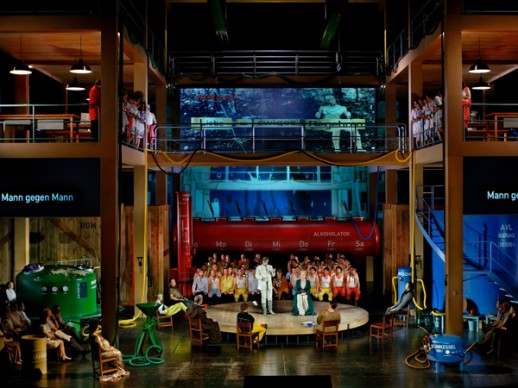
In Act III, the pilgrims returned in the form of newly promoted factory workers, their sacks upgraded to pants and athletic shirts. They showed their gratitude by frenetically dusting and cleaning the machinery. In another nod to the actual plot of the work, Elisabeth scanned the pilgrims for Tannhäuser. Wolfram then sang his ode and forced Elizabeth into the Biogas tank, killing her. Tannhäuser returned without a staff and sang an anguished Rome narration and then rejected Venus before collapsing.
Then, with no motivation at all, the Venusberg rose from the floor with the sirens from the first act rejoicing. The Pope showed up, the sperm-poles did a happy dance, Elisabeth emerged unharmed from her time in the swamp gas isolation tank and Venus joined the fun holding her newborn baby, indicating the possibility of a better world, or that, at least, the cycle would get the fresh meat it would need to continue.
There was, an interesting idea at the heart of the production as it tried to explore the nature of salvation. However, the actual execution was incoherent and self-indulgent as the primary interest of the director was the Technocrat installation rather than presenting the opera. I also believe that an audience should be able to appreciate the milieu and intent of the staging without having either thoroughly read the program notes or a chemical engineering degree.
As an indication of the director’s attitude towards the work, he wrote in the program notes that he wanted to present the work without intermission so the audience would not leave the realm of the installation. He then claimed that the caterer wouldn’t allow. I had always assumed that, given the powerful Bratwurst lobby in Franconia, key artistic decisions at Bayreuth were made by the caterers.
Thomas Hengelbrock opted for the so-called Dresden version of the opera, which is the opera as it was first published. He wanted to do an earlier version that would more closely resemble work as it was first performed in Dresden in 1845, but the Festival didn’t allow it, probably because this would not be one of The Master’s sanctioned versions of this oft tinkered with work. His conducting showed a propensity for perversely slow tempos at strategic moments. Even so, we were spared what would have been an insufferable ballet and more music for Venus, which was sung quite hideously by Stephanie Friede, who has a car alarm of a voice and no compensating distinction in stage deportment.
Otherwise the cast was reasonably strong. Lars Cleveman was a compelling Tannhäuser, capable of projecting his character’s anguish. Neither the vicissitudes of the Rome Narrative nor the staging posed him any obvious difficulties. Michael Nagy gave us a warm lyrical Wolfram van Eschenbach and his Ode to the BioReactor was one of the evening’s highlights. Camilla Nylund’s Elisabeth sounded rather generic vocally lacking the heft and sheen that more compelling singers have brought to the part. Gunther Groissbock was indisposed, so he acted the part of the Landgrave while Kwangchul Youn sang the part from a music stand at the side of the stage with reasonable degree of authoritativeness.
Do they really not have covers in Bayreuth, even for new productions? I assume not because we had a last minute substitution for Walther von Stolzing in Meistersinger the night before. Stefan Vinke had apparently arrived quite late on the evening before the performance and had managed to learn the staging and do a quick refresher on the music in a matter of hours. He did quite well, barely looking at the prompter and only needing an occasional gentle push from Eva. Someone should have told him after the first act that he didn’t need to scream as much as he did. Even so, he had sufficient reserves to muscle his way through the evening, only lightly damaging the music in the process.
The performance I saw of Die Meistersinger is supposedly the last for Katharina Wagner’s production. She took a bow at the end with designer Tilo Steffens and was vociferously booed. There was also extended booing after Act II. The production remains largely as seen on the DVD of the production I reviewed (and for which La Cieca provided a detailed exegesis in the comments). She did add some business for the Meistersingers where they took the Eucharist by consuming pages of a specially chosen book.
On second viewing, I admired the fierce relentlessness with which she pursued her argument, and the cogency with which she argues her thesis. However, her view of the work allows no room for any humanity for any of the characters. Watching it anew was akin to reading an autopsy report. Even so, the second half of the last act is such great theater that one forgives the very big chill that precedes it.
Musically, this was not at a festival level. Sebastian Weigle conducted like a bored guide on a bus tour, desultorily pointed out the landmarks. Adrian Eröd as Beckmesser gave the only truly memorable performance, fully realizing the director’s multi-faceted vision of his character. The chorus did perform at an exalted level and executed the complex staging flawlessly.
Photos: Bayreuther Festspiele / Enrico Nawrath.















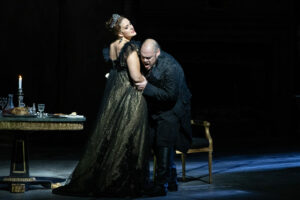

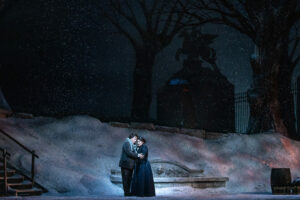
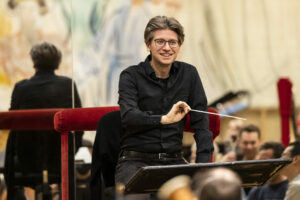

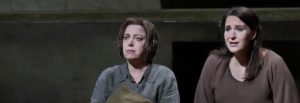




Comments